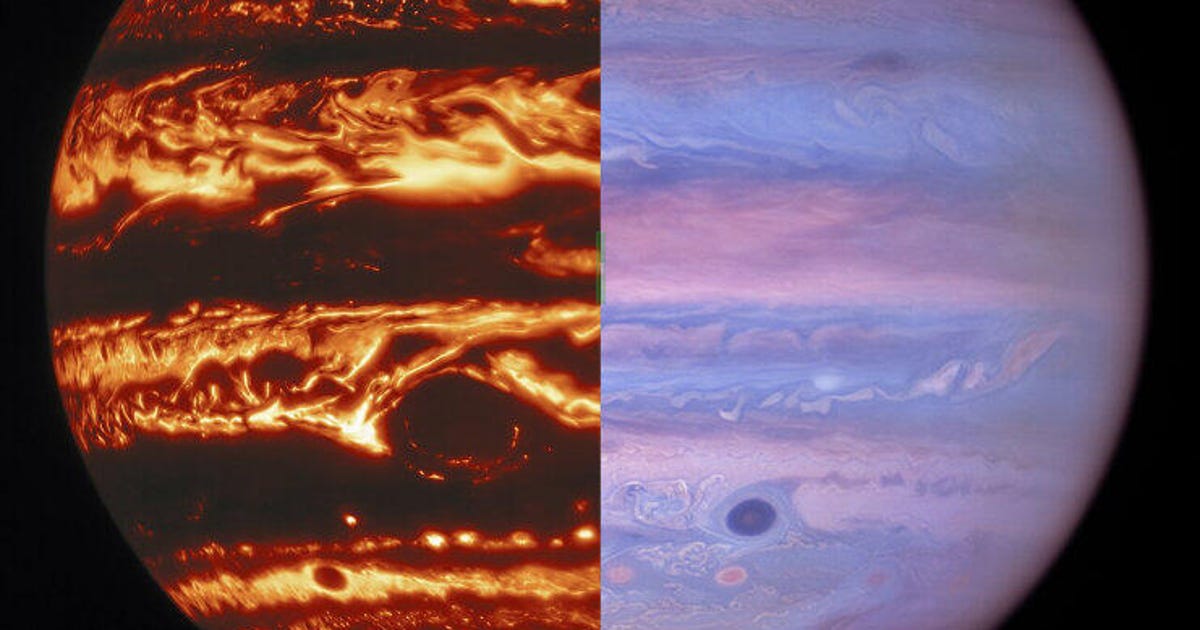
This image shows Jupiter as seen in infrared by Gemini North, visible light by Hubble and ultraviolet, also from Hubble.
International Gemini Observatory/NOIRLab/NSF/AURA/NASA/ESA, M.H. Wong and I. de Pater (UC Berkeley) et al.We typically see images of Jupiter in visible light that gives it a swirly beige, orangish and reddish appearance. But when telescopes look at the gas giant in other wavelengths of light, different features pop out.
The Gemini North telescope in Hawaii teamed up with NASA and ESA's Hubble Space Telescope to view Jupiter at the same time. Gemini North picked up an infrared image while Hubble handled visible light and ultraviolet light. Seen together, the three views show off the many moods of stormy Jupiter.
The telescopes snapped the images on Jan. 11, 2017, and the National Science Foundation's NoirLab astronomy research center released the trio of views on Tuesday.
"These three portraits highlight the key advantage of multiwavelength astronomy: viewing planets and other astronomical objects at different wavelengths of light allows scientists to glean otherwise unavailable insights," said NoirLab, pointing out how the planet's famous Great Red Spot storm system is prominent in visible and ultraviolet, but nearly disappears when seen in infrared.
NoirLab released interactive versions of the images that let you slide between the observations to see the striking differences for yourself.
A labeled version of the Hubble visible-light view shows off some of the planet's distinctive features, including a superstorm and a smaller red area named Red Spot Jr.
This labeled Hubble Space Telescope visible light view of Jupiter points out some of its scenic areas.
NASA/ESA/NOIRLab/NSF/AURA/M.H. Wong and I. de Pater (UC Berkeley) et al.The Great Red Spot has been the subject of much study. The massive, iconic storm has been active since at least the early 1800s, though it's also appeared to shrink at times. Researchers are now using the different wavelength views to better understand the spot's structure. What they found were surprising holes in the Great Red Spot.
The holes are still under investigation. "The closest analog is eddies in the ocean," said planetary scientist Mike Wong of the University of California, Berkeley. "As the storm clouds spin, you can get little anomalies from these eddies that form streaks by just winding up. And that's kind of the shape that we're seeing in these holes. So it's probably just some weak turbulence, but as it spins, it gets stretched out."
Jupiter's wild and crazy storms will remain objects of fascination, but these far-reaching telescope views will help scientists see through some of the planet's mysteries.
Follow CNET's 2021 Space Calendar to stay up to date with all the latest space news this year. You can even add it to your own Google Calendar.
"light" - Google News
May 13, 2021 at 09:05AM
https://ift.tt/3f8DnWM
Jupiter looks stunning in three different wavelengths of light on one day - CNET
"light" - Google News
https://ift.tt/2Wm8QLw
https://ift.tt/2Stbv5k
Bagikan Berita Ini















0 Response to "Jupiter looks stunning in three different wavelengths of light on one day - CNET"
Post a Comment